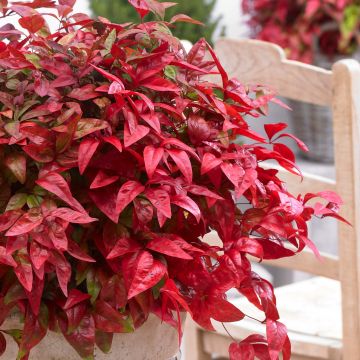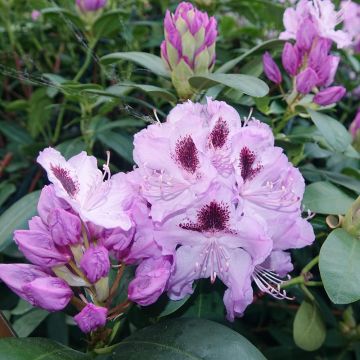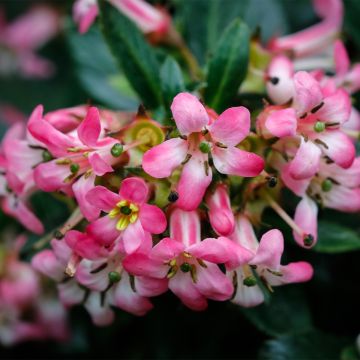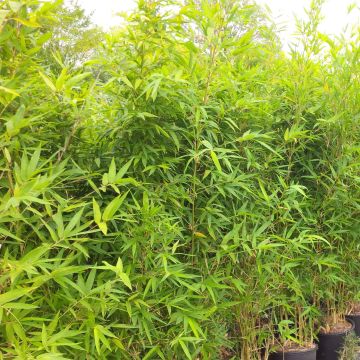

Nandina domestica Sunrise - Sacred Bamboo


Nandina domestica Sunrise - Sacred Bamboo


Nandina domestica Sunrise - Sacred Bamboo
Nandina domestica Sunrise - Sacred Bamboo
Nandina domestica 'Monfar' SUNRISE (MAGICAL® series)
Heavenly Bamboo, Sacred Bamboo
This item cannot be shipped to the selected country
Delivery charge from €5.90
Delivery to Corse prohibited
More information
Schedule delivery date,
and select date in basket
This plant carries a 24 months recovery warranty
More information
We guarantee the quality of our plants for a full growing cycle, and will replace at our expense any plant that fails to recover under normal climatic and planting conditions.
From €5.90 for pickup delivery and €6.90 for home delivery
Express home delivery from €8.90.
Delivery to Corse prohibited: UE law prohibits the import of this plant from mainland France to Corse as part of the fight against Xylella fastidiosa. Please accept our sincere apologies.
More information
Does this plant fit my garden?
Set up your Plantfit profile →
Description
The Sacred Bamboo or Nandina domestica Magical Sunrise, from the cultivar name 'Monfar' is part of the MAGICAL® series collection. This relatively compact variety offers a superb foliage, delicate and fine, adorned in spring with a subdued shade of brick orange. The summer foliage is green and then turns into beautiful autumnal hues of gold and red. It forms a ball-shaped bush with thin, upright or arching stems, sometimes accompanied by small white flowers in spring. Versatile, easy to grow, and very graphic, this evergreen bush integrates perfectly into flower beds, as a standalone specimen or in large borders, as well as in a large container on a terrace.
The Sacred Bamboo Magical Sunrise belongs to the Berberidaceae family. This bush is a horticultural selection of the Nandina domestica native to India, China, and Japan. Its growth is rather slow, reaching an adult size of approximately 1.20m in height and spread. This plant forms multiple upright, branched stems from its rhizomatous base. They resemble bamboo stems and are adorned with leaves cut into long, narrow, pointed leaflets. Its foliage is dense, compact, and nicely rounded. The plant is beautiful all year round: its young shoots of a somewhat muted and unusual orange turn later into chartreuse green, then dark green in summer, and finally orange-red to golden in autumn. It eventually produces large conical panicles of cream-white flowers in late spring, measuring 30 to 40 cm long. If the summer is long and warm enough, these are followed by abundant clusters of very decorative bright red fruits. It is advisable to plant another Sacred Bamboo nearby to ensure fruiting, as the plant is not self-fertile. The fruits persist on the branches for a long time into winter.
The Nandina domestica Magical Sunrise is particularly elegant in large plantings, where it harmoniously pairs with plants such as Mexican orange blossom, Japanese spirea 'Little Princess', Griffith's spurge, Isalia ground cover roses, or daylilies. Each combination creates a successful picture. This small bush is also stunning in a large container on a terrace, provided it is exposed to non-burning sun and receives regular watering. In a large border, it pairs perfectly with Thunberg's bush clover and dwarf abelias.
Report an error about the product description
Nandina domestica Sunrise - Sacred Bamboo in pictures


Plant habit
Flowering
Foliage
Botanical data
Nandina
domestica
'Monfar' SUNRISE (MAGICAL® series)
Berberidaceae
Heavenly Bamboo, Sacred Bamboo
Cultivar or hybrid
Other Nandina
Planting and care
Plant the Sacred Bamboo Magical Sunrise in a soft, deep, well-drained soil, even slightly chalky, moist to occasionally dry. Once well established, this plant adapts perfectly to summer drought if the soil is deep. It prefers sunny, non-burning situations, or partial shade, but can also grow under the cover of sparse trees. Avoid drying winds and reserve a sheltered location from severe cold. This bush is hardy down to -15°C under optimal conditions, so it will be useful to protect its base with a thick mulch of dead leaves before winter in the coldest regions. If the above-ground part were to freeze, the plant should be pruned back to ground level in February-March. Pruning is limited to removing dead wood and excess or weak branches in winter.
Planting period
Intended location
Care
This item has not been reviewed yet - be the first to leave a review about it.
Evergreen shrubs
Haven't found what you were looking for?
Hardiness is the lowest winter temperature a plant can endure without suffering serious damage or even dying. However, hardiness is affected by location (a sheltered area, such as a patio), protection (winter cover) and soil type (hardiness is improved by well-drained soil).

Photo Sharing Terms & Conditions
In order to encourage gardeners to interact and share their experiences, Promesse de fleurs offers various media enabling content to be uploaded onto its Site - in particular via the ‘Photo sharing’ module.
The User agrees to refrain from:
- Posting any content that is illegal, prejudicial, insulting, racist, inciteful to hatred, revisionist, contrary to public decency, that infringes on privacy or on the privacy rights of third parties, in particular the publicity rights of persons and goods, intellectual property rights, or the right to privacy.
- Submitting content on behalf of a third party;
- Impersonate the identity of a third party and/or publish any personal information about a third party;
In general, the User undertakes to refrain from any unethical behaviour.
All Content (in particular text, comments, files, images, photos, videos, creative works, etc.), which may be subject to property or intellectual property rights, image or other private rights, shall remain the property of the User, subject to the limited rights granted by the terms of the licence granted by Promesse de fleurs as stated below. Users are at liberty to publish or not to publish such Content on the Site, notably via the ‘Photo Sharing’ facility, and accept that this Content shall be made public and freely accessible, notably on the Internet.
Users further acknowledge, undertake to have ,and guarantee that they hold all necessary rights and permissions to publish such material on the Site, in particular with regard to the legislation in force pertaining to any privacy, property, intellectual property, image, or contractual rights, or rights of any other nature. By publishing such Content on the Site, Users acknowledge accepting full liability as publishers of the Content within the meaning of the law, and grant Promesse de fleurs, free of charge, an inclusive, worldwide licence for the said Content for the entire duration of its publication, including all reproduction, representation, up/downloading, displaying, performing, transmission, and storage rights.
Users also grant permission for their name to be linked to the Content and accept that this link may not always be made available.
By engaging in posting material, Users consent to their Content becoming automatically accessible on the Internet, in particular on other sites and/or blogs and/or web pages of the Promesse de fleurs site, including in particular social pages and the Promesse de fleurs catalogue.
Users may secure the removal of entrusted content free of charge by issuing a simple request via our contact form.
The flowering period indicated on our website applies to countries and regions located in USDA zone 8 (France, the United Kingdom, Ireland, the Netherlands, etc.)
It will vary according to where you live:
- In zones 9 to 10 (Italy, Spain, Greece, etc.), flowering will occur about 2 to 4 weeks earlier.
- In zones 6 to 7 (Germany, Poland, Slovenia, and lower mountainous regions), flowering will be delayed by 2 to 3 weeks.
- In zone 5 (Central Europe, Scandinavia), blooming will be delayed by 3 to 5 weeks.
In temperate climates, pruning of spring-flowering shrubs (forsythia, spireas, etc.) should be done just after flowering.
Pruning of summer-flowering shrubs (Indian Lilac, Perovskia, etc.) can be done in winter or spring.
In cold regions as well as with frost-sensitive plants, avoid pruning too early when severe frosts may still occur.
The planting period indicated on our website applies to countries and regions located in USDA zone 8 (France, United Kingdom, Ireland, Netherlands).
It will vary according to where you live:
- In Mediterranean zones (Marseille, Madrid, Milan, etc.), autumn and winter are the best planting periods.
- In continental zones (Strasbourg, Munich, Vienna, etc.), delay planting by 2 to 3 weeks in spring and bring it forward by 2 to 4 weeks in autumn.
- In mountainous regions (the Alps, Pyrenees, Carpathians, etc.), it is best to plant in late spring (May-June) or late summer (August-September).
The harvesting period indicated on our website applies to countries and regions in USDA zone 8 (France, England, Ireland, the Netherlands).
In colder areas (Scandinavia, Poland, Austria...) fruit and vegetable harvests are likely to be delayed by 3-4 weeks.
In warmer areas (Italy, Spain, Greece, etc.), harvesting will probably take place earlier, depending on weather conditions.
The sowing periods indicated on our website apply to countries and regions within USDA Zone 8 (France, UK, Ireland, Netherlands).
In colder areas (Scandinavia, Poland, Austria...), delay any outdoor sowing by 3-4 weeks, or sow under glass.
In warmer climes (Italy, Spain, Greece, etc.), bring outdoor sowing forward by a few weeks.























































